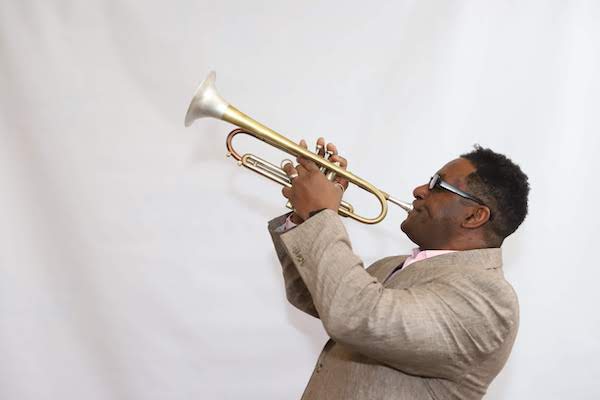Oct 28, 2025 10:47 AM
In Memoriam: Jack DeJohnette, 1942–2025
Jack DeJohnette, a bold and resourceful drummer and NEA Jazz Master who forged a unique vocabulary on the kit over his…

“I express my emotions better musically than socially most of the time,” Marcus Printup said.
(Photo: Adam McCullough)Marcus Printup swung around New York’s Columbus Circle behind the wheel of his black Cadillac SUV, stopping briefly under the Jazz at Lincoln Center sign to scoop up a writer and head home to New Jersey.
Printup, who has spent half of his 53 years in the trumpet section of the Jazz at Lincoln Center Orchestra, would fly out with the band the next day for a European tour that would consume February. He had plenty to do before then—not least, secure the home front for his wife, harpist Riza Printup.
Despite the rush, he had agreed to talk to DownBeat at some length. And if he was antsy about it, he didn’t let on. By his own account, Printup often keeps his feelings buttoned up—speaking, when possible, through his trumpet, especially when it comes to, well, tooting his own horn. It’s a quality with some virtues.
“I express my emotions better musically than socially most of the time,” he said as he munched on a cracker at his home.
But that reticence can, at times, leave him in a kind of professional half-light—more vulnerable to the Wynton Marsalis effect than he might otherwise be. Marsalis, a cultural monument and one of America’s most famous jazz musicians, often presides over the JLCO from a seat in the trumpet section—casting a shadow that can eclipse the enormous talents of the bandmates he earnestly promotes.
Marsalis shone a spotlight on Printup at the JLCO’s concert at the Elbphilharmonie in Hamburg, Germany. About 90 minutes into the performance—and a short five days after the conversation in Printup’s home—Marsalis laid a laurel on his fellow trumpeter before the band launched into Marcus’ “Salvation, Serenity, Reflection.”
“You can’t get any deeper than he is,” Marsalis told the packed crowd in the concert hall and the global audience livestreaming the event.
Since he was a teenager in Conyers, Georgia, Printup has been digging into the roots of jazz—and coming up with the goods. At the Elbphilharmonie, his opening salvo on “Salvation”—a deceptively simple, decidedly soulful solo turn that led seamlessly into the heart of the gospel-inspired waltz—prompted an ovation.
“He’s got something in his sound,” said JLCO baritone saxophonist Paul Nedzela. “As soon as he’s done playing, the audience is already in love with the tune.”
Printup chalked up that “something” to his years in Conyers, where his family members were dutiful choristers of the Peek’s Chapel Baptist Church. Though he was the reluctant choir recruit, he listened closely to the preacher’s tremulous cadences and pitches. “There’s a certain sound I heard from those deacons. When I play, that’s where it comes from.”
His writing, too, can have the pulse of the pulpit, as the buoyant swing and sway of “Salvation” suggests. Part of a suite called Of Thee I Sing, the piece is just one of the 40-plus JLCO charts Printup has produced.
But the pulpit is not Printup’s sole influence. His chart for Wayne Shorter’s “Armageddon,” for example, utilizes the language of a very contemporary jazz, evoking what he called “the end of the world” with a 15-instrument cacophony of “musical chaos.”
Less scriptural, but no less spiritual, is his take on tunes with a more secular sensibility. On Ahmad Jamal’s “Manhattan Reflections,” a divine shout chorus “that’s all me” sets off range-appropriate instruments assigned to Jamal’s right and left hands. On Paul Simon’s “50 Ways To Leave Your Lover,” another such chorus blissfully enlivens a chart largely “geared for his voice and the band.”
In the past, the composers of these tunes were on hand during rehearsals, though it was Shorter who, with his unhurried way of getting precisely to the point, made a particular impression. The impact of the 2015 visit on Printup was profound: “He helped me find my voice more so than any other musician has. His mere presence elevated us in so many ways.”
But it’s safe to say that Printup has felt most elevated by his collaboration with Riza. The two found each other in 2006, meeting through a mutual friend. Riza accepted an invitation to dinner, they hit it off and, by 2010, they were married. The union has proved both fruitful and comfortable.

Jack DeJohnette boasted a musical resume that was as long as it was fearsome.
Oct 28, 2025 10:47 AM
Jack DeJohnette, a bold and resourceful drummer and NEA Jazz Master who forged a unique vocabulary on the kit over his…

D’Angelo achieved commercial and critical success experimenting with a fusion of jazz, funk, soul, R&B and hip-hop.
Oct 14, 2025 1:47 PM
D’Angelo, a Grammy-winning R&B and neo-soul singer, guitarist and pianist who exerted a profound influence on 21st…

To see the complete list of nominations for the 2026 Grammy Awards, go to grammy.com.
Nov 11, 2025 12:35 PM
The nominations for the 2026 Grammy Awards are in, with plenty to smile about for the worlds of jazz, blues and beyond.…

Flea has returned to his first instrument — the trumpet — and assembled a dream band of jazz musicians to record a new album.
Dec 2, 2025 2:01 AM
After a nearly five-decade career as one of his generation’s defining rock bassists, Flea has returned to his first…

Drummond was cherished by generations of mainstream jazz listeners and bandleaders for his authoritative tonal presence, a defining quality of his style most apparent when he played his instrument unamplified.
Nov 4, 2025 11:39 AM
Ray Drummond, a first-call bassist who appeared on hundreds of albums as a sideman for some of the top names in jazz…





